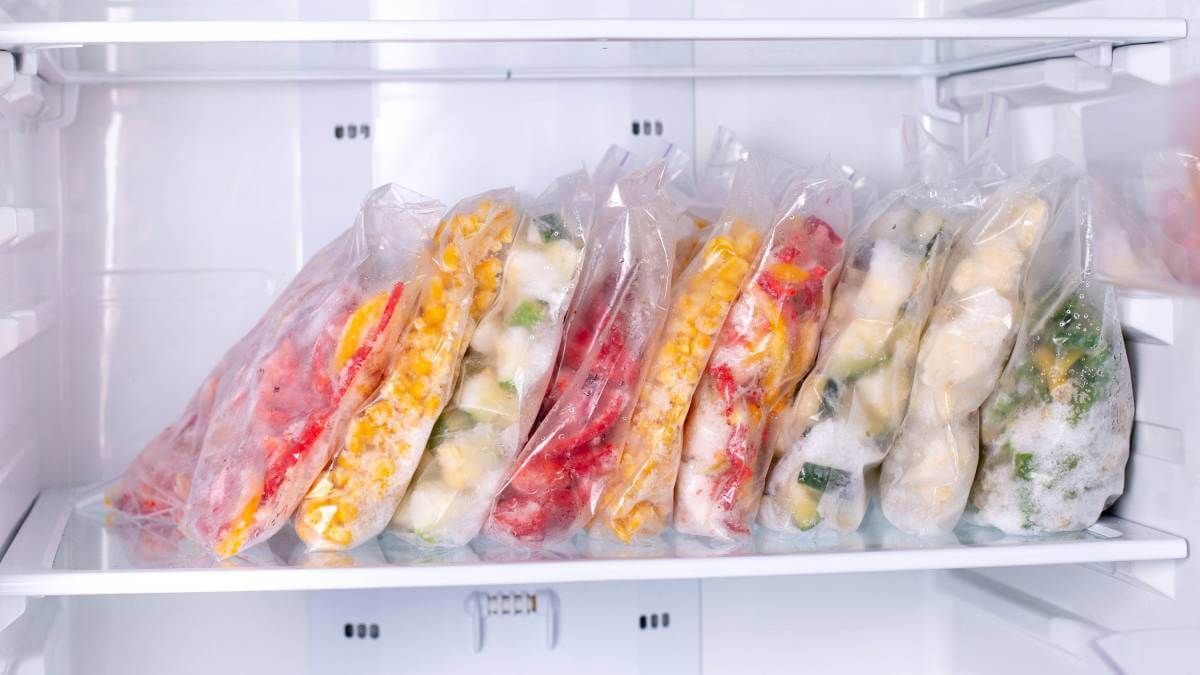It’s all too easy to just shove things you want to freeze into any freezer drawer that’ll hold it, without labelling it or having any idea of where it’s actually located when you need it for a meal.
But instead of rummaging around every nook and cranny until your fingers turn blue, wondering what on earth the countless bags and boxes of mystery frozen items actually are, giving your freezer a deep clean and adopting a new, organised approach to your frozen food can save you time, and make delving into the freezer far less daunting.
View this post on Instagram
“A lot of our customers struggle to fit frozen goods in the freezer because its jam-packed full of old Tupperware or loose, often unidentifiable food,” says food expert Stuart Pritchard. “We often forget about things we’ve saved for a rainy day, as they’re right at the back, covered in ice. Just by taking stock and being a bit smarter about how and where you store things, you’ll find your freezer has a lot more free space – which will save valuable time when you’ve got hungry mouths to feed. And it also means less food will go to waste.”
Here are 10 tips for having a super-organised freezer.
1. Out with the old
The first step is to rid your freezer of any unlabelled containers or food you know you’ll never get round to cooking, making space for a perfectly categorised freezer, says Mr Pritchard. It’s also time to fix any broken drawers – if they’re beyond repair, you can usually order a replacement from the manufacturer. And consider removing shelves, as you can fit more in if you do.
2. Get prepared
View this post on Instagram
You’ll need some good quality sealable freezer bags, freezer paper or foil, a marker pen and Tupperware pots that are a uniform size. Measure the drawers before buying the pots, to work out what size you need, to fit the most into the space, advises Mr Pritchard. Other useful tools are a tray to help you freeze items on a flat surface, as well as a freezer itinerary sheet.
3. Repackage everything
Frozen foods often come in awkwardly-shaped bags and boxes. Removing the packaging and placing the food into sealable containers or bags means you can fit more in. Using containers that are a uniform size will help make the most of the freezer space. Mr Pritchard suggests freezing sauces and soups by decanting them into a sealable freezer bag and labelling. Put smaller containers – containing things such as herbs or cooking ingredients – into a larger box to keep them together.
4. Avoid the burn

Although foods with freezer burn – which happens when food becomes dehydrated when air reaches it – are still safe to eat, they don’t look as appetising or taste as good. To prevent freezer burn, wrap food tightly in cling wrap/freezer paper/foil to prevent air from getting to it, before popping it inside a bag or container.
5. Freeze flat
Freeze sauces and soups flat on a baking tray, which should catch any drips, suggests Mr Pritchard. And rather than freezing mince in round bulky bags, put it in a sealable bag and use a rolling pin to flatten it out – making the size and shape similar to other items. Once solid, you can remove frozen liquids from the tray and stack alongside similar sized items.
6. Label
Experts stress labelling is vital for an organised freezer. “Always include what’s inside, plus the date it was frozen,” stresses Mr Pritchard. “You can also include the use-by-date, so you know when it’s time to use up older food, or clear out and restock.”
7. Categorise shelves
View this post on Instagram
Freeze food in categories to make it easier to find. Try having designated shelves for different items. One shelf for easy access items – such as bread, pastry, batch-cooked meals and cooking ingredients, one for fruit and vegetables – including chips and potatoes, one for meat and fish, and one for desserts and ice cream.
8. Create an inventory
“An inventory will help you see at a glance what’s in the freezer and keep on top of restocking without having to rummage through countless drawers, bags and boxes,” says Mr Pritchard. Storing the frozen food in categories will help make your inventory easier to follow.
9. Batch cook
Batch cooking is one of the best ways to use your freezer. It takes almost no extra time to make double of something, then you can simply portion and freeze the rest for another day.
10. Know what can – and can’t – be frozen

There are some foods many people just don’t realise can be frozen. Hard cheese is one, just cut it into useable chunks before freezing. Another is eggs which can be frozen in ice cube trays and popped out the day before needed, and wine, which can also be frozen in ice cube trays and added into stews, casseroles etc without the need to open another bottle.
But Mr Pritchard points out that foods with a high water content, such as cucumber and lettuce, don’t freeze well, as the water inside forms ice crystals, which can make them soggy when defrosted. He says other foods to avoid freezing are dairy foods with a high fat content, such as soft cheeses and cream, as they separate and go lumpy when frozen. Bottles of beer are another no-no.
He also highlights two food items that are dangerous to freeze – food in a tin, which may swell and make the tin explode, and eggs still in their shells. The water inside an egg will expand when frozen and crack the shell, making it vulnerable to bacteria growth.
How organised is your freezer? Do you know everything that’s in there? Let us know in the comments section below.
Also read: Is batch cooking the secret to saving money?
– With PA

